How to Craft Brand Messaging Your Target Audience Will Love
As a consumer — and a marketer — one of my favorite brands to watch is Taco Bell. In the last five years or so, Taco Bell has begun making strides in its brand messaging.
The brand has reinvented itself on social media, introducing a new, bold personality. With its food, packaging, marketing campaigns, events, philanthropic efforts, and interior design, Taco Bell reinvented itself into a full on lifestyle brand.
Doing this — telling a compelling brand story through messaging — isn't easy.
Marketers need to have an entire brand identity to communicate what their business does, what it's about, and why it's different. Oh, and it needs to resonate with people and strengthen your company's values and reputation.
This is because, according to research from Bergische University, brands produce similar feelings as the ones we feel when we like someone. So, we actually feel similarly about brands as we do about people.
That's why marketers need to craft brand messaging that their audience can relate to.
Below, let's review brand messaging — what it is and a framework to get started.
It's how your consumers can have a relationship with your brand. Ultimately, it's the culmination of language, design, events, and philanthropic efforts that tell the story of who your brand is.
So, how do you get started crafting brand messaging that your target audience will love?
You need to know two things like the back of your hand: your target audience and unique value proposition.
Then, you can begin to write out a brand identity that'll help your company make all its marketing decisions. Would a brand that cares about "X" do this? Would a brand that's motivated by "Y" sell this?
Your brand identity will inform your company's behavior because it'll tell you why your brand matters, what it stands for, and why it's different from other brands.
A brand identity that your audience relates to and has a personality — or talks to your audience like a friend — is how you'll continue to remain relevant to your consumers and create loyal customers.
Brand Message Framework
With a full understanding of brand messaging and creating a brand identity, you might be wondering, "Now what? How do I get started?"
And it's a fair question. That's why we've created a brand message framework that you can use to begin crafting a brand message or identity.
1. Figure out who you are.
To get started, your brand message needs to answer these questions:
- How do you differentiate from your competitors?
- What is your unique value proposition?
- What kind of messaging will resonate with your target audience?
- Who is your target audience? What do they care about?
- Does your brand message tell a story?
- What are your company's goals? (No one is perfect and your target audience can't relate to a seemingly perfect brand).
- What are your company's values?
While you're answering these questions and beginning to map out who your brand identity is and what your brand messaging will look like, remember that your brand message answers the question, why? Why does your audience care?
2. Know your audience.
Now that you have a better idea of what you offer and who you are, you need to understand who your audience is. If you haven't already, create buyer personas that represent who your customers are and their goals. This will help you find alignment between your brand and your consumers.
3. Start a document that explains your brand message.
After you've answered the questions above and written out your personas, begin compiling this information in a document that explains what your brand message is, your unique value proposition, and key themes that are core to your brand identity.
Then, start to figure out how your brand identity relates to your buyer persona. What are the patterns and what do they have in common? This is how you'll make decisions on brand messaging. You'll see what your audience cares about that align with your values and can derive messaging opportunities.
4. Brainstorm messaging opportunities.
With a clear document that represents who you are and who your audience is, you can then begin to look for messaging opportunities. How can you relate your current campaigns to your brand message? How can you use content to convey your values?
Once you have an idea, you can create a tagline that communicates who you are and your unique value proposition.
At this point, you should have created a brand message and identity that'll inform your messaging. Now, we wanted to review a few tips for creating messaging that stays true to your brand:
- Stay focused on the brand positioning: With all the content you write, ask yourself, "Is this true to our values?"
- Relate to your audience: When you create content, use your buyer personas and brand messaging document to ensure that you're talking about something that's relevant to your audience.
- Don't be perfect: Similarly to the point above, people aren't perfect and brands shouldn't be either. Don't over promise and communicate that you're perfect, because you aren't and it'll come off disingenuous.
- Communicate your message everywhere: In everything you write and all your marketing decisions, think about your brand message. Whether you're writing copy for your website, creating slogans for packaging, or marketing an event, your copy needs to communicate your brand message.
- Be simple: Keep it simple. If your brand's personality or overall values are confusing or hard to discern, people won't relate to you. The last thing you want to do is create a brand message that your audience is confused by.
1. Taco Bell
As mentioned above, Taco Bell has started to create a reputation for its strong, funny brand. If you tweet them, they will likely respond with a humorous comment.
The goal is to be so relatable that customers love to interact and talk about Taco Bell. When people are talking about you and with you, they're more likely to be loyal customers.
Below is an example of a tweet that represents Taco Bell's brand identity and messaging. They respond to tweets like a sarcastic, funny best friend would.
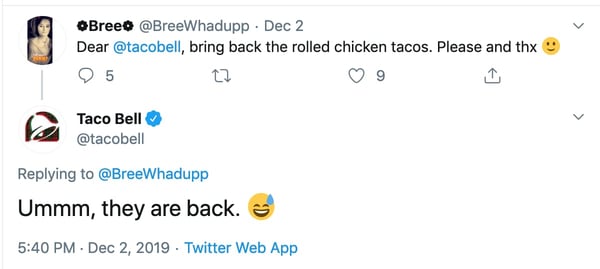
2. TheSkimm
TheSkimm is a daily newsletter that aims to quickly inform young women of current events. The brand is known for having a bold, witty personality similar to that of its target audience — millennial women.
The goal? To mirror its target audience. Act like the fun, irreverent best friend to help readers get started with their day.
In the tweet below, theSkimm stays true to its brand messaging and identity by starting off with a sharp, witty comment on Congress.

3. Proclaim
Proclaim is a lingerie line that is "expanding the definition of nude, one ethically made bra at a time." They tackle the lack of inclusivity in women's undergarments by creating products for all skin tones, and they do it with sustainable, Earth-friendly products. This value proposition is combined with their messaging, which celebrates diversity and nature.

4. FabFitFun
When I think of FabFitFun, I think of trendy products that are popular with self-care influencers. The brand has cultivated a following by partnering with influencers on Instagram who are trendy, fashionable, and take care of themselves.
And this image of self-care and trendy products is carried out through its content as well. Below, the company tweeted its blog about trendy tech accessories. This type of content is right in line with the brand messaging consumers hear about on Instagram.
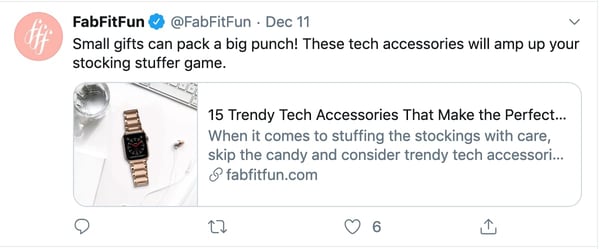
5. Trader Joe's
Trader Joe's is a grocery store that has created an almost cult-like following through its brand messaging. They are a fun, cheap, organic food store with a small-town, neighborhood feel. For example, they even put out an old-fashioned newsletter called the "Fearless Flyer." This includes product roundups and recipes.
The content Trader Joe's puts out reinforces its brand image as a small, neighborhood grocery store. With brand messaging that is consistent with its unique value proposition and personality, customers relate to the brand as if it were a person.
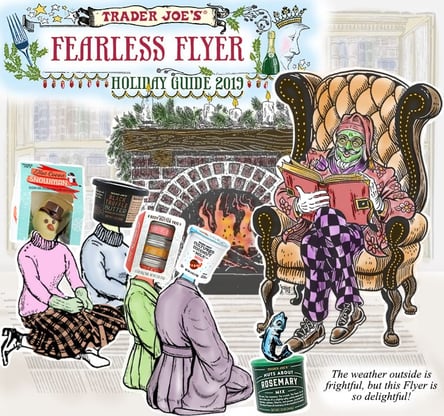
6. Taylor Swift
Besides the fact that Taylor Swift is one of my favorite singer/songwriters, I had to include her because her brand messaging is on point.
From the time she was 16, Taylor Swift has used social media and brand messaging to connect with her fans. This is another example of someone who has created a cult-like following through brand messaging.
Taylor Swift's brand is that she's like the girl next door, something her audience relates with. In the example below, someone on Tumblr posted a tweet on Swift's birthday, and Swift responded like … well, like the girl next door. A fun, outgoing best friend you can easily talk to on social media.
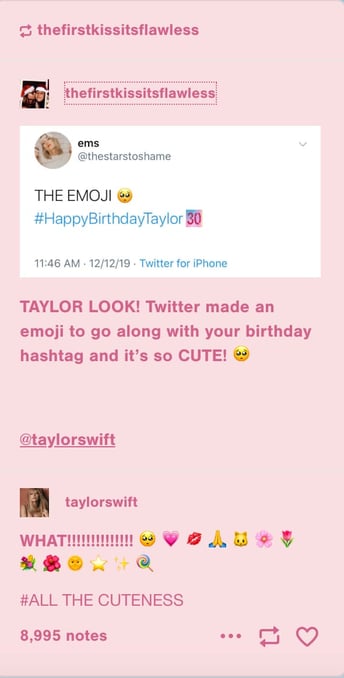
7. Hillary Weiss
Large brands have more resources to invest into branding and awareness, so this list would not be complete without at least one personal brand (since I'm not sure that Taylor counts). Hillary Weiss is a great example to look to if you want an example of brand messaging that speaks directly to prospects. Her personality literally jumps off the page...
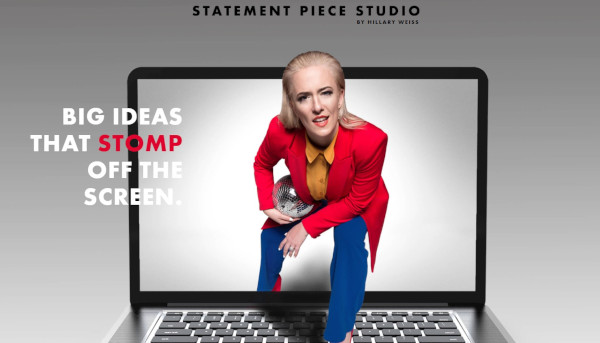
... And it's her goal to make others' do the same with their brand positioning and copywriting. She comes right out and says it on her website:
"I'm Hillary Weiss, and I turn small businesses like yours into HUGE obsessions. Since 2011, I’ve helped thousands of personality-fueled brands define their Statement Piece — a.k.a. the big idea that makes them unmissable in their market, and radically relevant to their perfect people. Now it’s your turn. Let’s get loud (and rich) together."
8. Loom
Good messaging often comes down to conveying value to your target audience and why you're doing what you're doing. Loom is a great example of this, and it helps that they have an amazing product.
Their homepage says, "Say it with video" along with their tagline: "The expressiveness of video with the convenience of messaging. Communicate more effectively wherever you work with Loom." The rest of their website backs up the assertion with facts to provide their point. For example, "You talk up to 6 times faster than you type" and "Video conveys emotion and tone of voice that text simply can't."
Even better, their brand messaging is further underscored in the testimonials of brand evangelists who truly believe in this value:
@loom you’re changing lives over here. I know @imcatnoone and @ConnorPM feel similarly. pic.twitter.com/a9qzt1shfm
— Alberto Orsini 🇵🇷 (@albertojorsini) August 28, 2020
9. Dove
Branding goes so further than what you sell and why it's valuable. Dove recognizes this by making their brand about more than just having the best soap and care products. To them, their products mean enhancing the natural beauty of their customers and (more importantly) that beauty should be "a source of confidence, not anxiety."
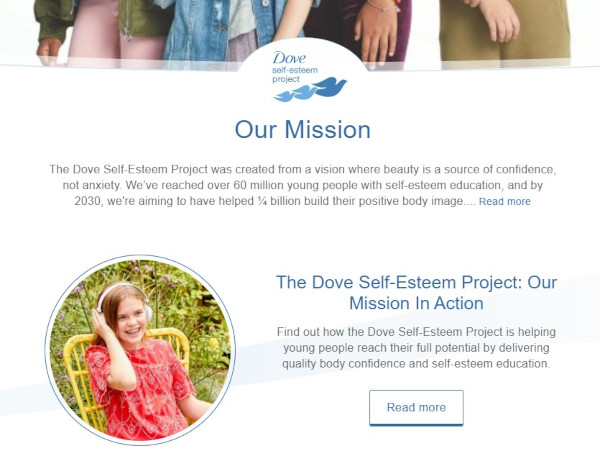
That's why Dove invests into realizing that mission with their Self-Esteem Project and taking a different approach with their advertising than simply discussing the features of their soap.
10. Métier Brewing Company
Speaking of missions, Métier Brewing Company, founded in 2018, isn't just a brewery; it's an organization that's embedded in the community (and that means making the community better). According to their website, "Great beer should be for everyone, and we don’t just mean the people drinking it. At MBC, we brew beer with everybody in mind: the suppliers who produce our ingredients, the brewers brewing, the staff who serve pints, and the broader community enjoying the beer."
They embody this mission in all facets of their business from their beer hall and event space for hosting concerts and family gatherings to their support of The Major Taylor Project (an after-school bike education program to foster a sense of belong and empower youth, particularly those from underrepresented communities).
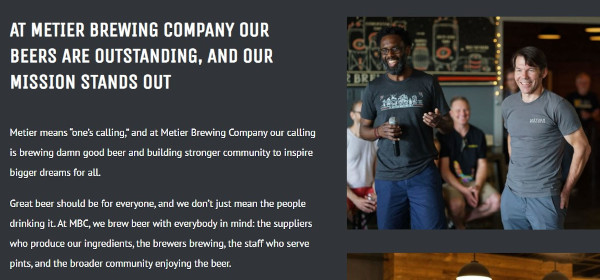
Your personality and values should be evident and align with that of your audience. Your brand message is something that's strategically created to help you stand out and relate to your customers. For this reason, it can make a big difference in how you're perceived by prospects (and whether or not they want to do business with you), so start building your brand today.
Editor's note: This post was originally published in December 2019 and has been updated for comprehensiveness.
from Hubspot
Comments
Post a Comment